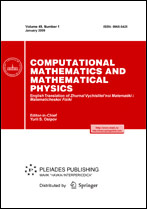|
This article is cited in 5 scientific papers (total in 5 papers)
Partial Differential Equations
Biharmonic obstacle problem: guaranteed and computable error bounds for approximate solutions
D. E. Apushkinskayaab, S. I. Repincd
a 66041 Saarbrücken, P.O. Box 151150, Saarland University, Germany
b Peoples' Friendship University of Russia (RUDN University), Moscow, 117198 Russia
c 40014 Jyväskylä, P.O. Box 35 (Agora), University of Jyväskylä, Finland
d Steklov Institute of Mathematics at St. Petersburg, St. Petersburg, 191023 Russia
Abstract:
The paper is concerned with an elliptic variational inequality associated with a free boundary obstacle problem for the biharmonic operator. We study the bounds of the difference between the exact solution (minimizer) of the corresponding variational problem and any function (approximation) from the energy class satisfying the prescribed boundary conditions and the restrictions stipulated by the obstacle. Using the general theory developed for a wide class of convex variational problems we deduce the error identity. One part of this identity characterizes the deviation of the function (approximation) from the exact solution, whereas the other is a fully computed value (it depends only on the data of the problem and known functions). In real life computations, this identity can be used to control the accuracy of approximate solutions. The measure of deviation from the exact solution used in the error identity contains terms of different nature. Two of them are the norms of the difference between the exact solutions (of the direct and dual variational problems) and corresponding approximations. Two others are not representable as norms. These are nonlinear measures vanishing if the coincidence set defined by means of an approximate solution satisfies certain conditions (for example, coincides with the exact coincidence set). The error identity is true for any admissible (conforming) approximations of the direct variable, but it imposes some restrictions on the dual variable. We show that these restrictions can be removed, but in this case the identity is replaced by an inequality. For any approximations of the direct and dual variational problems, the latter gives an explicitly computable majorant of the deviation from the exact solution. Several examples illustrating the established identities and inequalities are presented.
Key words:
variational inequalities, estimates of the distance to the exact solution, aposteriori estimates.
Received: 17.06.2020
Revised: 17.06.2020
Accepted: 07.07.2020
Citation:
D. E. Apushkinskaya, S. I. Repin, “Biharmonic obstacle problem: guaranteed and computable error bounds for approximate solutions”, Zh. Vychisl. Mat. Mat. Fiz., 60:11 (2020), 1881–1897; Comput. Math. Math. Phys., 60:11 (2020), 1823–1838
Linking options:
https://www.mathnet.ru/eng/zvmmf11159 https://www.mathnet.ru/eng/zvmmf/v60/i11/p1881
|


|





 Contact us:
Contact us: Terms of Use
Terms of Use
 Registration to the website
Registration to the website Logotypes
Logotypes








 Citation in format
Citation in format 
